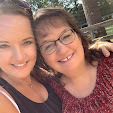
Cuna indian girls wearing molas stitched to their blouses which were made by their mothers.
One of the most interesting textile art forms I have ever scene is the art of mola making traditionally done by the Cuna indians of San Blas Islands, Panama. My mother brought one home after visiting Panama and I just knew I had to try to make one some day. I was amazed to realize that the designs on her 'picture' were done by reverse applique but with many layers of different colored cloth and in pencil thin lines. It was a beautiful piece of stitching and art.
Click on the following link to see a wonderful web page on Molas and the beautiful Indian women who make them. It is a great page for kids! It has intriguing native music playing in the background as well. http://charlottepatera.com/html/MAKE%20A%20MOLA/makeamola.html
 In America, we do a very simple form of reverse applique using only two pieces of cloth. We cut away the shapes we want to reveal from the top layer of cloth to show a color below and then stitch the raw edges of the top layer down to the bottom layer. This technique is used for flowers, leaves, or even animal shapes. But never do we attempt such intricate lines or so many layers of cloth.
In America, we do a very simple form of reverse applique using only two pieces of cloth. We cut away the shapes we want to reveal from the top layer of cloth to show a color below and then stitch the raw edges of the top layer down to the bottom layer. This technique is used for flowers, leaves, or even animal shapes. But never do we attempt such intricate lines or so many layers of cloth.

There is very little information available on how to do this, but as you can see from this picture, I am attempting a practice piece. I also bought a book from Dover publishing that has many authentic Mola indian designs that I may try to use for a piece for next year's art festival. It is much harder to do than it looks but it is really fun to try!

This is my second attempt. The cloth on my first mola was too thick allow me to do a good job on the applique stitches. In this mola, my lines are still wide. The pieces of cloth layered beneath the top layer of black cloth were not even, which is why the blue shows through the fish at the bottom. In the photo, you can see at the top that I have just cut slits to reveal blue for radiating lines. I used a white chalk marking pencil to draw the main designs and to plan out where I was going to cut. I'm mostly designing as I go.

Molas were made by the Kona indian women of Panama to replace body painting. A woman sews two identical pieces, one for the front of her blouse or dress and one for the back. She wears the dress with the mola until the dress is worn and/or faded and then rips the mola off and sews it onto another dress until she is tired of it. Then she rips it off again and sells it to local tradesmen who sell it to tourists. The average cost you will pay to buy one is around $75 to upwards of $200.00. If the mola doesn't have torn threads on the edges, or isn't a little worn or faded, it probably isn't authentic. The tourist versions are often made by machine and are not very well done. The artwork is also not usually traditional.
 The most authentic mola designs are geometric. More contemporary ones incorporate more modern imagery. You will often see flowers, fish, birds, and other jungle animals. You will sometimes see Christian imagery from missionary influence. Some molas have indian spirit symbolism in them, if they are for religious purposes.
The most authentic mola designs are geometric. More contemporary ones incorporate more modern imagery. You will often see flowers, fish, birds, and other jungle animals. You will sometimes see Christian imagery from missionary influence. Some molas have indian spirit symbolism in them, if they are for religious purposes.To learn more about this art see the rest of the links below.
- Kuna Indian women and their art - http://www.panart.com/molainfo.htm
- Mola Art Gallery - http://thorup.com/mola.html
- How Molas are made - http://thorup.com/makeamola.html
- Detailed instructions on how to make a simple Bug Mola. (Very Good!) http://charlottepatera.com/html/MAKE%20A%20MOLA/makeamola.html
- Kid's Construction Paper Mola project- http://www.artprojectsforkids.org/2008/08/how-to-make-mola.html
- Link to a great book -Molas!: Patterns, Techniques & Projects for Colorful Applique (Paperback-Buy used for less than $5.00)http://www.amazon.com/Molas-Patterns-Techniques-Projects-Colorful/dp/1579902235/ref=sr_1_3?ie=UTF8&s=books&qid=1227384982&sr=1-3


















Social Buttons